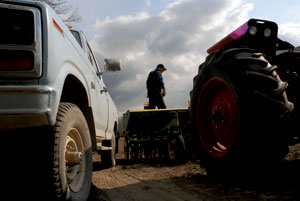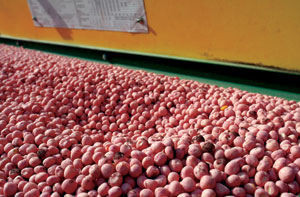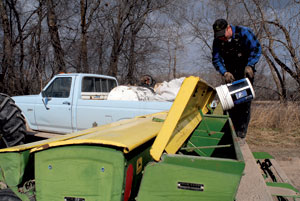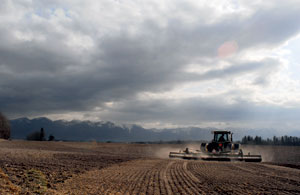In theory, farmers should be sitting pretty with record crop prices.
In reality, they’re still pinching pennies, with the price of diesel and fertilizer also soaring.
This year many farmers are putting a lot more pennies into their operations hoping to take advantage of market conditions, Mother Nature permitting. With more money out there for the taking, farmers are willing to pony up for the expensive operational costs.
“Farmers are gamblers and they’re willing to bet,” said John Youngberg, vice president of governmental affairs for the Montana Farm Bureau (MFB).
The MFB recently responded to what it perceives as a widespread misconception that farmers are inherently reaping benefits from high food prices. Not enough attention, the bureau and other farmers argue, is given to skyrocketing input prices such as diesel and fertilizers. Diesel costs more than $4 per gallon in some states. According to the National Agricultural Statistics Service (NASS), fertilizer prices increased 37 percent overall from March 2007 to March 2008, though in some cases specific fertilizers have doubled or tripled in cost.
 |
|
Mark Siderius carries a bucket of fertilizer from his truck across the back of a grain drill. The drill plants the pea seeds and fertilizes the ground at the same time. |
These input prices, farmers say, put the squeeze on producers even with record food prices. After factoring the expenses put into growing, harvesting and processing, the break-even point for farmers is significantly higher than in past years.
“If you look at the amount the farmer gets when (food’s) on the shelf, it’s pretty minimal,” Youngberg said. “If you look at the net profit … these people are about the same as about three or four years ago.”
Everybody is feeling the pain of lofty commodity prices this year, from farmers to the middle men like bakers and livestock operators who use crops to feed their animals, and from food retailers to, of course, the consumers. Food grain prices have increased by more than 100 percent in the past year while grains and hay used for livestock feed have increased by nearly 40 percent, according to NASS.
Much of the talk swirling around high food prices centers on wheat, which jumped as high as $20 per bushel earlier in the year and has since leveled out closer to $10. Wheat prices traditionally average about $3 to $4 per bushel.
Vincent Smith, an economics professor specializing in agriculture for Montana State University, said Montana farmers are expected to plant 5 percent more acres of wheat this year, reflecting a national trend. A rise in supply will start driving down prices. It’s not possible, Smith said, for current prices to continue.
“If we have a normal growing season,” Smith said, “we’re likely to see record or near record levels of wheat production across the world.”
 |
|
The main compartment of the grain drill is filled with pea seeds before planting. The seeds are covered with a pink inoculate treat that helps to protect them from predators until they grow. |
The ethanol effect
Increased ethanol production, following a 2005 federal mandate to produce substantial amounts of corn ethanol fuel, is often cited as a main culprit in escalating food prices. Smith said it follows logically that if more corn is being used for non-food purposes, food prices will take a hit.
Twenty percent of corn production in the U.S., Smith said, goes into ethanol production, and the U.S. produces 50 percent of the world’s corn supply, which means 10 percent of the world’s corn goes into ethanol. On top of that, overall corn production is expected to decline this year following a sharp spike in 2007.
“That’s a lot of corn going into non-food, (non) animal feed use,” Smith said.
The Montana Farm Bureau argues that too much blame is placed on ethanol production for driving up food prices, once again pointing to input costs.
“There’s a continuing diatribe that ethanol production is what’s driving up food costs,” Youngberg said. “There have been significant food costs, but it may be a small portion of that.”
 |
|
Mark Siderius fills the back of his grain drill with fertilizer before plaint peas on about 90 acres of land between Creston and Kalispell. |
Mark Siderius, a farmer who operates east of Kalispell, isn’t planting spring wheat this year for fear of the orange wheat blossom midge, a feisty little bug that wreaked havoc on Flathead’s wheat fields two years ago. He said other Flathead farmers are doing the same, benefiting from the versatility of the Flathead’s fertile soil. Siderius is planting peas and barley this spring.
Barley, another crop at record price, and peas are not only market-friendly now, but they’re also helpful in combating high input prices, Siderius said. These crops, along with others like canola and lentils, require little fertilizer.
Betting the farm
If farmers are able to find ways to mitigate input prices, and if the weather is stable during growing season, Siderius said this year could be special for farmers. But it won’t come without risk. He said he’s putting more money into this farming season than ever before, so much, in fact, that he is taking out an insurance program for the first time. He’s betting that it could be his most profitable year yet.
“Whatever crop we have, as long as we harvest it and get it into the bin, it’s going to be a winner,” he said.
Current prices are tempting enough to draw farmers nationwide out of the Conservation Reserve Program (CRP), a federal program designed to protect sensitive areas from cultivation. Roughly 8 percent of the nation’s total cropland is protected by CRP.
The baking and livestock industries have pushed for flexibility within the program to free up acres for cultivation, thus increasing crop supplies and decreasing prices. Last month the American Baking Association orchestrated a march in Washington, D.C. to protest high wheat prices. Environmental and hunting groups oppose looser regulations.
Jeremy Seidlitz, executive director of the Montana Cattlemen’s Association, said beef prices, which have managed to remain stable, can only hang on for so long in the face of expensive feed grain and corn.
“I don’t know how much the cattle industry will absorb before they start increasing prices,” Seidlitz said.
 |
|
Mark Siderius finishes smoothing and compacting a field before planting peas between Creston and Kalispell. |
Farmers can choose not to renew their contracts for CRP, which many have done, as more than 2 million CRP acres have been dropped nationwide in favor of cultivation since last September. But for farmers still in the program, Smith, the MSU professor, said that even if they choose to spurn the program and pay the heavy price for breaking contract, not many would be able to get in on this year’s growing season. Spring planting season is already underway.
“Essentially you’ve got to homestead the land again,” Smith said of turning the wild, unprepared land into farming fields.
But for farmers who have no protected land and are free to play the market this year, the possibility of building a little financial cushion is refreshing.
“It’s a real nice time to be farming,” Siderius said, “to be able to look out and have a bright horizon in front of us.”